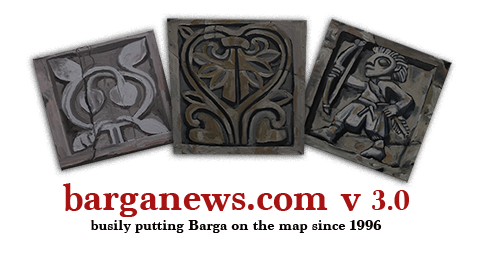Barga’s long and tumultuous history is the source of incessant questions from visitors, and endless speculation on the part of the Barghigiani.
Its iconic cornerstones are the the single-masted seaborne vessel that apears on the town coat of arms – a peculiar symbol for a mountain community – the enormous statue of St. Christopher that stands in the Duomo, and the peculiar architecture and “feel” of the Duomo itself.
In “Storia di San Cristoforo”- Origine a diffusione di un culto tra mito e realtà ( Libria, 2018 ), the prolific art historian Sefano Borsi, a son of Barga and eminent member of the faculty of the Universita degli studi di Napoli, delves three millennia into the past in search of answers.
A packed room turned out at the Fondazione Ricci on Saturday (23 June), to hear Professor Borsi discuss the principal conclusions of his latest work
At their heart lies a scholarly thesis enveloped in mystery: Borsi believes that Barga’s origins and religious practices are ancient indeed, predating the arrival of both Christianity and the Greco-Roman deities it replaced.
The vast, austerely rectalinear nave of the Duomo, surveyed by the towering oak statue at its eastern end, officially dates back “only” a thousand years or so. Yet its form and some of its foundation stones appear to be far older than that, and to walk into the Duomo is as close as a modern traveler can get to the actual sensation of entering a temple dedicated to the giant forest and river gods of Italy’s lost Celto-Ligurian civilization, circa 800 BC.
Questo saggio affronta la storia di oltre dieci secoli del culto dedicato a san Cristoforo, ricostruendone in modo dettagliato le vicende e il contesto storico, le forme e le modalità di diffusione, la stratificazione agiografica, le scelte iconografiche e architettoniche, le collocazioni geografiche e la distribuzione territoriale dei luoghi di culto, le lontane premesse e l’antico sostrato precristiano, le molteplici ragioni delle diverse stagioni della variegata fortuna popolare sino al declino, delineando una corposa e documentata sintesi che attraversa il mondo mediterraneo e il continente europeo contribuendo a restituire un panorama fresco e originale su una fitta trama di relazioni religiose, sociali, culturali ed economiche.
A tutto questo si aggiunge l’indagine in profondità sugli edifici a intitolazione cristoforica di alcune aree campione, partendo da un caso particolare – Barga e la diocesi di Lucca in epoca medievale – per estendere il campo di ricerca fino alla scala continentale.
Un mondo poco conosciuto ma denso di suggestioni, che delinea un’insospettata ma non trascurabile traccia della nostra complessa identità culturale. – Buy the book on line here

